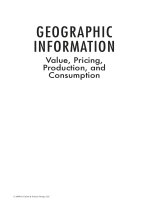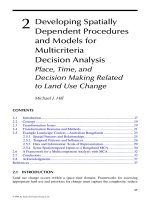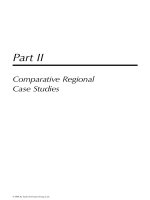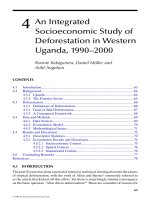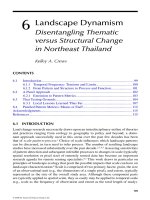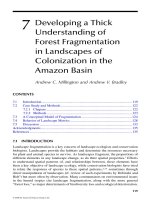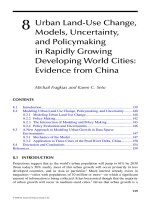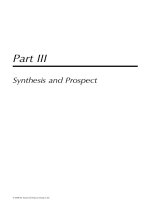Land Use Change: Science, Policy and Management - Chapter 1 pot
Bạn đang xem bản rút gọn của tài liệu. Xem và tải ngay bản đầy đủ của tài liệu tại đây (413.05 KB, 34 trang )
Land Use
Change
Science, Policy
and Management
© 2008 by Taylor & Francis Group, LLC
Land Use
Change
Science, Policy
and Management
Edited by
Richard J. Aspinall
Michael J. Hill
CRC Press is an imprint of the
Taylor & Francis Group, an informa business
Boca Raton London New York
© 2008 by Taylor & Francis Group, LLC
CRC Press
Taylor & Francis Group
6000 Broken Sound Parkway NW, Suite 300
Boca Raton, FL 33487-2742
© 2008 by Taylor & Francis Group, LLC
CRC Press is an imprint of Taylor & Francis Group, an Informa business
No claim to original U.S. Government works
Printed in the United States of America on acid-free paper
10 9 8 7 6 5 4 3 2 1
International Standard Book Number-13: 978-1-4200-4296-2 (Hardcover)
is book contains information obtained from authentic and highly regarded sources. Reprinted
material is quoted with permission, and sources are indicated. A wide variety of references are
listed. Reasonable efforts have been made to publish reliable data and information, but the author
and the publisher cannot assume responsibility for the validity of all materials or for the conse-
quences of their use.
No part of this book may be reprinted, reproduced, transmitted, or utilized in any form by any
electronic, mechanical, or other means, now known or hereafter invented, including photocopying,
microfilming, and recording, or in any information storage or retrieval system, without written
permission from the publishers.
For permission to photocopy or use material electronically from this work, please access www.
copyright.com ( or contact the Copyright Clearance Center, Inc. (CCC)
222 Rosewood Drive, Danvers, MA 01923, 978-750-8400. CCC is a not-for-profit organization that
provides licenses and registration for a variety of users. For organizations that have been granted a
photocopy license by the CCC, a separate system of payment has been arranged.
Trademark Notice: Product or corporate names may be trademarks or registered trademarks, and
are used only for identification and explanation without intent to infringe.
Library of Congress Cataloging-in-Publication Data
Land use change : science, policy, and management / Richard J. Aspinall and
Michael J. Hill [editors].
p. cm.
Includes bibliographical references and index.
ISBN 978-1-4200-4296-2 (hardcover : alk. paper)
1. Land use Environmental aspects. 2. Land use Management. 3. Land
use Case studies. I. Aspinall, Richard J. II. Hill, Michael J. (Michael James),
1937- III. Title.
HD108.3.L362 2008
333.73’13 dc22 2007027752
Visit the Taylor & Francis Web site at
and the CRC Press Web site at
© 2008 by Taylor & Francis Group, LLC
RJA — to Chloe, for her company
MJH — to my mother, Mavis Hill,
for her lifelong friendship
© 2008 by Taylor & Francis Group, LLC
vii
Contents
Figures ix
Permissions xi
Preface xiii
Acknowledgments xv
Introduction xvii
Editors xxiii
Contributors xxv
PART I Theory and Methodology
Chapter 1 Basic and Applied Land Use Science 3
Richard J. Aspinall
Chapter 2 Developing Spatially Dependent Procedures and Models for
Multicriteria Decision Analysis: Place, Time, and Decision
Making Related to Land Use Change 17
Michael J. Hill
PART II Comparative Regional Case Studies
Chapter 3 Spatial Methodologies for Integrating Social and
Biophysical Data at a Regional or Catchment Scale 43
Ian Byron and Robert Lesslie
Chapter 4 An Integrated Socioeconomic Study of Deforestation in
Western Uganda, 1990–2000 63
Ronnie Babigumira, Daniel Müller and Arild Angelsen
Chapter 5 Modeling Unplanned Land Cover Change across Scales:
A Colombian Case Study 81
Andres Etter and Clive McAlpine
Chapter 6 Landscape Dynamism: Disentangling Thematic versus
Structural Change in Northeast Thailand 99
Kelley A. Crews
© 2008 by Taylor & Francis Group, LLC
viii Contents
Chapter 7 Developing a Thick Understanding of Forest Fragmentation in
Landscapes of Colonization in the Amazon Basin 119
Andrew C. Millington and Andrew V. Bradley
Chapter 8 Urban Land Use Change, Models, Uncertainty, and
Policymaking in Rapidly Growing Developing World Cities:
Evidence from China 139
Michail Fragkias and Karen C. Seto
PART III Synthesis and Prospect
Chapter 9 Synthesis, Comparative Analysis, and Prospect 163
Michael J. Hill and Richard J. Aspinall
© 2008 by Taylor & Francis Group, LLC
ix
Figures
Figure I Conceptual model of sustainability choice space.
Figure 2.1 The concept of grazing piospheres interacting with landscape structure.
Figure 2.2 Time series approaches to extracting signal summary indicators.
Figure 2.3 Nonbiophysical time series also provide potential indicators.
Figure 2.4 The spatial pattern of temporal signals may be grouped by applying prin-
Figure 2.5 Temporal signals are usually based on biophysical or human phenomena.
Figure 2.6 A framework for application of multicriteria analysis of ecosystem services
to the range land environment.
Figure 2.7 Cognitive mapping interface.
Figure 2.8 Schema for transformation of spatiotemporal information.
Figure 3.1 Land use change in the Barmera, Berri, and Renmark areas of South
Australia.
Figure 3.2 Location of the Glenelg Hopkins region.
Figure 3.3 Land managers’ perception of salinity and mapped salinity discharge sites.
Figure 3.4 Land managers who manage properties near areas of high conservation
value.
Figure 4.1 Uganda study area showing the distribution of reforestation.
Figure 4.2 Conceptual framework for analysis.
Figure 4.3 Cumulative deforestation by parishes across Uganda.
Figure 4.4 Relationship between deforestation and distance from roads.
Figure 5.1 Location of Colombia.
Figure 5.2 Predicted forest presence according to the best model.
Figure 5.3 Predicted deforestation hot spots.
Figure 5.4 Forest maps of the colonization front.
Figure 5.5 Spatial location of the local hot spots of deforestation and regeneration.
Figure 5.6 Logistic pattern of forest cover decline during the transformation process.
Figure 5.7 Forest cover change at the local scale in the Colombian Amazon.
Figure 6.1 The panel process, conducted at both the pixel and patch levels.
Figure 6.2 Typical nuclear village settlement as seen in 1:50,000 scale.
Figure 6.3 LULC in the greater study area in several water years.
Figure 6.4 Stylized LULC trends observed and/or reported in northeast Thailand.
Figure 6.5 Stylized LULC pattern metric change for the interspersion/juxtaposition
index.
Figure 6.6 The change in conguration from 1972/1973 to 1975/1976.
Figure 7.1 Thick and thin understandings of forest fragmentation along roads in
lowland forests of the Amazon Basin.
Figure 7.2 Sequence of images showing progressive deforestation.
Figure 7.3 Six-phase conceptual model of forest fragmentation.
Figure 7.4 Metrics calculated for the conceptual model.
Figure 7.5 Selected metrics.
© 2008 by Taylor & Francis Group, LLC
cipal components analysis.
x Figures
Figure 7.6 Metrics calculated for Communidad Arequipa.
Figure 8.1 Population distribution of the world’s urban agglomerations.
Figure 8.2 The Pearl River Delta in southeast China.
Figure 8.3 Predicted probability of change to urban areas between 2004 and 2012
for Shenzhen.
Figure 8.4 Predicted probability of change to urban areas between 2004 and 2012
for Foshan.
Figure 8.5 Predicted probability of change to urban areas between 2004 and 2012
for Guangzhou.
Figure 8.6 Shenzhen, Guangzhou, and Foshan urban/nonurban prediction for 2012.
Figure 9.1 Integrating frameworks that seek interdisciplinary denition and focus
on key questions of management of land use change in coupled human
environment systems.
Figure 9.2 A diagram of the major elements of the coupled human environment
system.
Figure 9.3 Connecting the paradigms.
Figure 9.4 The context for spatial and temporal analysis in determining the mix of
landscapes of fate and desire.
© 2008 by Taylor & Francis Group, LLC
xi
Permissions
Figure I Potschin, M. and Haines-Young, R., “Rio+10,” sustainability science
and landscape ecology, Landscape and Urban Planning, 75, 162–174,
2006. Reprinted with permission from Elsevier.
Figure 5.2 Etter, A. et al., Regional patterns of agricultural land use and defor-
estation in Colombia, Agriculture, Ecosystems & Environment, 114,
369–386, 2006. Reprinted with permission from Elsevier.
Figure 5.3 Etter, A. et al., Regional patterns of agricultural land use and defor-
estation in Colombia, Agriculture, Ecosystems & Environment, 114,
369–386, 2006. Reprinted with permission from Elsevier.
Figure 5.4 Etter, A. et al., Characterizing a tropical deforestation wave: the
Caquetá colonization front in the Colombian Amazon, Global
Change Biology, 12, 1409–1420, 2006. Reprinted with permission
from Blackwell Publishing.
Figure 5.5 Etter, A. et al., Characterizing a tropical deforestation wave: the
Caquetá colonization front in the Colombian Amazon, Global
Change Biology, 12, 1409–1420, 2006. Reprinted with permission
from Blackwell Publishing.
Figure 5.6 Etter, A. et al., Modeling the conversion of Colombian lowland eco-
systems since 1940: drivers, patterns and rates, Journal of Environ-
mental Management, 79, 74–87, 2006. Reprinted with permission
from Elsevier.
Figure 5.7 Etter, A. et al., Unplanned land clearing of Colombian rainforests:
spreading like disease?, Landscape and Urban Planning, 77, 240–254,
2006. Reprinted with permission from Elsevier.
Table 5.1 Etter, A. et al., Modeling the conversion of Colombian lowland eco-
systems since 1940: drivers, patterns and rates, Journal of Environ-
mental Management, 79, 74–87, 2006. Reprinted with permission
from Elsevier.
Figure 9.1a IGBP Secretariat, Global Land Project: Science Plan and Imple-
mentation Strategy, GLP, IGBP Report 53/IHDP Report 19, 64 pp,
2004. Reprinted with permission from the International Geosphere
Biosphere Program, Stockholm.
Figure 9.1d Steinitz, C. et al., Alternative Futures for Changing Landscapes:
The Upper San Pedro River Basin in Arizona and Sonora, 2003.
Reprinted in modied form with permission from Island Press,
Washington D.C.
© 2008 by Taylor & Francis Group, LLC
xiii
Preface
There is a growing international community of scholars who work on themes and
issues that are central to understanding land use change as a fundamental factor in the
operation of environmental and socioeconomic systems at scales from local to global.
This book presents a series of chapters that address spatial theories, methodologies,
and case studies that support an integrated approach to analysis of land use change.
Case studies provide a series of regional test beds for theories and methodologies,
and the empirical content of the case studies allows a comparative analysis of land
use change issues from diverse places. Case studies thus are an important mecha-
nism, not only for understanding the multiscale nature and consequences of land
use change and the particular history of changes in case study locations, but also for
eliciting general principles and factors of importance in different socioeconomic,
cultural, and environmental contexts. This generalization from case studies provides
input to decision making related to possible future trajectories of change.
The chapters in this book were written to present this interaction of theories,
methodologies, and case studies. Additionally, all the authors are concerned with
links between science and decision making, especially in relation to policy and
practice. Each author attempts to enable effective communication between the aca-
demic content of his or her work with decision makers, including those concerned
with policy and those concerned with land management.
All the chapters were rst presented in a paper session at the 6th Open Meeting of
the International Human Dimensions of Global Environmental Change Programme
in Bonn, October 2005—Spatial Theory and Methodologies for Integrated Socio-
economic and Biophysical Analysis and Modeling of Land Use Change: An Inter-
national Test of Theory and Method and a Comparative Synthesis of Change at Local
and Regional Scales.
© 2008 by Taylor & Francis Group, LLC
xv
Acknowledgments
We thank the authors of the chapters for their prompt responses to all our requests.
We also thank Professor Roy Haines-Young and Dr. Marion Potschin, University
of Nottingham, for their participation in the session at the International Human
Dimensions of Global Environmental Change Programme open meeting in Bonn,
Germany, in October 2005 at which the papers and ideas in this book were rst
presented and discussed. We also thank Tai Soda and Amber Donley from Taylor
& Francis/CRC Press for their patient prompting and management during the
preparation of this book.
© 2008 by Taylor & Francis Group, LLC
xvii
Introduction
This book addresses spatial theories and methodologies that support an integrated
approach to analysis of land use change. The work focuses on spatial representation
and modeling for scientic study and development of management understanding
of complex, dynamic land use systems. Case studies are used to develop specic
examples, not only of change in the study areas used by the different case studies, but
also to illustrate the variety and commonality of data sources, methods, and issues
faced when studying and developing understanding of land use change.
Land use and land cover change reect a variety of environmental and social
factors.
1,2
This necessitates that an equally varied suite of data be used for effective
analysis. Remote sensing, from both satellites and air photos, provides a central
resource for study of land use and land cover change. Socioeconomic surveys and
censuses provide an equally important source of data on social and economic
systems. Atlases and other map sources can provide data on specic environmental
and socioeconomic characteristics of an area. Similarly, household and other
surveys can give information on motivations, values, behaviors, and actions of deci
-
sion makers and land managers, and there are many other specic data of relevance
for study of land use change. These different data do vary, however, in their avail
-
ability, currency, and relevance for study of land change, and this is reected in the
variety of case studies in the published literature and the specic issues and ques
-
tions they address.
Similarly, methods that are appropriate for analysis of the different data sources
are varied, and study of land change typically may involve methods from remote
sensing, GIS (geographic information systems), process and empirical modeling, and
spatial and statistical analysis, among others, as well as methods that can address
qualitative and quantitative data. The need to study land use as a coupled natural
and human system adds to the complexity of methods needed since interaction of
systems and integration in analysis present major methodological challenges.
Thus, the purpose of this book is to illustrate issues and opportunities for study
of land change by discussing relevant science and methods and by providing a series
of exemplary case studies that present approaches, data, and methods to study
land use change. Various themes run through the book, including the wide use of
remote sensing, GIS (often implicit and supporting analysis rather than explicit and
a goal of the work), and a variety of statistical and other modeling methods aimed
at understanding spatial and temporal trends, patterns, and dynamics. The central
importance of understanding the social, economic, policy, cultural, and institutional
contexts and inuences on land change is also a recurrent theme.
A further set of issues, and a major context for interpretation of results of the
chapters, is associated with sustainable development and the emergence of sustain
-
ability science.
3,4,5
Sustainable development provides a context and focus for scientic
research
4,6,7
as well as a guide and impetus for civic debate and decision-making.
5,8
Potschin and Haines-Young
7
present a conceptual model (the “tongue model”) of the
© 2008 by Taylor & Francis Group, LLC
xviii Introduction
state of a landscape and its development trajectory over time (Figure I). This treats
landscapes as multifunctional spaces and is founded on a paradigm of natural capital
and ecosystem services.
9,10
The tongue model places boundaries on sustainability
dened by a combination of biophysical limits of ecological systems in a landscape;
this reects not only environmental conditions and ecosystem services that can be
achieved, but also social and cultural values, as well as costs and uncertainties that
can be accepted. The tongue model
7
provides a useful framework for development
and evaluation of the models and case studies of land use and land cover change
presented in Chapters 3 through 8. The case studies also provide a test of the gen
-
eral applicability of the tongue model since they explore a diverse range of socio-
economic, cultural, and biophysical contexts for land use systems. Effective linkage
of science, policy, land management practices, and decision-making related to land
and ecological systems will increasingly require frameworks such as this with a
focus on integration of human and natural systems that are explicitly directed at
achieving consensus based on a strong scientic foundation.
The case studies also focus attention on terminology, especially related to land
use and land cover. Land use refers to the social, economic, cultural, political, or
other value and function of land resources. This contrasts with land cover, which
refers to the biophysical properties of the land surface.
11
As such, land use and land
cover, although related, are distinct from one another. The distinctions are important
for understanding causes and consequences of change in land systems, as well as
for mapping and other measurement of land system properties. Indeed, one of the
main challenges to the study of land systems may be the tendency for conation and
confusion of the terms
land use and land cover. This partly relates to wide use of
remotely sensed imagery as a source of land system data but also to ambiguity and
lack of distinction in denition of categories of interest. For example, the Anderson
FIGURE I Conceptual model of sustainability choice space. (From Potschin and Haines-
Young.
7
With permission.)
Development options defined by
different interest groups
State indicator (e.g., area of a particular habitat)
Set of landscape configurations that more or less sustain
required landscape outputs for society. Boundary of
envelope set by minimum and maximum value of state
variable required to deliver outputs, given people’s
attitudes to risks and costs, and long-term uncertainties.
+
–
Z
1
– Z
0
time
© 2008 by Taylor & Francis Group, LLC
Introduction xix
classication,
12
which is widely used as a taxonomy for land surface description based
on imagery from different sources (as well as eld mapping), and many other clas
-
sications confound cover and use classes within the same formal mapping legend.
This may be based on apparent similarity in cover and use. For example, forestry (use)
and forest (cover) may refer to the same place on the ground. It does, however, have
important consequences for process-level understanding and modeling of change,
presenting a limitation for recording change and consequently for understanding.
Recently, efforts have been made to produce separate classications of land use
13
and
land cover,
14
and the Global Land Project
15
identies cover and use along a continuum
spanning natural and social systems.
STRUCTURE OF THE BOOK
The book is organized in nine chapters. Chapters 1 and 2 address theoretical and
methodological issues and mechanisms for study of land use systems as coupled
human and natural systems. Chapters 3 through 8 provide a suite of regional case
studies, including a discussion of change in rapidly urbanizing areas. Collectively,
these six chapters provide insight into the nature of both land use change and the
diverse range of socioeconomic, cultural, and biophysical contexts of land use sys
-
tems across the planet. The case study chapters provide a series of illustrations for
many of the frameworks, issues, and methodologies described in the rst two chap
-
ters. The empirical content of the case studies also allows a comparative analysis of
land use change issues from diverse places.
Chapter 1 considers basic science questions that underpin study of land use
change, as well as a suite of applied science issues that inuence the utility and
use of scientic information about land use change for policy and land manage
-
ment. The chapter focuses on issues that inuence the analysis of dynamics of land
change; the need for understanding the integration and feedbacks between different
components of land, climate, socioeconomic, and environmental systems; resilience,
vulnerability, and adaptability of land use systems; scale issues; and accuracy. The
chapter also examines some issues relevant to effective communication and partner-
ship between scientists and practitioners responsible for decision-making, either
policy or management, about land use.
Full understanding of both land use change and decision-making requires an
appreciation of multiple characteristics of land use systems and factors that inu
-
ence change. Multicriteria decision analysis can provide a series of tools to help with
both scientic study and decision-making. Chapter 2 examines the development of
spatially dependent procedures and models for such multicriteria decision analysis.
The approaches focus on reducing the complex responses and patterns associated
with land use change to simpler meaningful metrics. These are based on use of both
quantitative and qualitative measures of patterns and trends and include methods
from signal processing, time series analysis, and analysis of spatial patterns.
The next six chapters present a series of case studies that are exemplars of dif
-
ferent aspects of land use science. In Chapter 3 Byron and Lesslie explore inter-
actions between people and the environment as a critical component in regional- and
catchment-scale natural resource management. The chapter uses a case study from
© 2008 by Taylor & Francis Group, LLC
xx Introduction
Australia to bring data on the environment, from a time series of orthophotos, and social
systems, from a property survey, together. This integrated analysis is complemented
by use of spatially referenced survey data to understand how land managers’ values,
perceptions, and practices relate to the biophysical environments they manage.
Chapter 4, by Babigumira, Müller, and Angelsen, links deforestation in western
Uganda in the 1990s to the socioeconomic, spatial, and institutional contexts within
which it occurred. The authors develop an empirical model that integrates socio-
economic data from a national census with spatial data derived from remote sensing.
The socioeconomic survey informs on poverty and economic opportunities, whereas
the remotely sensed data represent the costs and feasibility of forests.
Chapter 5, by Etter and McAlpine, examines the patterns, processes, and drivers
of unplanned land cover change in Colombia as representative of change in the tropics.
Statistical modeling is used to predict changes in forest cover at local, regional, and
national levels, over times ranging from a decade to a century. Explanatory variables
include both biophysical and socioeconomic data, and these are obtained from a
range of sources, including remote sensing, maps, and surveys.
Chapter 6, by Crews-Meyer, is a case study of land change in northeast Thailand
that uses a time series of satellite-derived data within a longitudinal approach, panel
analysis, for modeling temporal dynamics. The approach also draws on landscape
ecology to emphasize the importance of the spatial scale of observation on the
inference of process and attempts to examine changes in landscape composition
and conguration.
Chapter 7, by Millington and Bradley, uses a case study of deforestation associ-
ated with planned colonization schemes in the Amazon Basin to develop a detailed—
thick—understanding of deforestation. They argue that the impacts of roads on forest
fragmentation are agents of deforestation at one scale only and that at another scale
the pattern of property ownership represents that scale at which land owners make
decisions about forest clearance and regrowth as household responses to economic
and policy signals.
Chapter 8, by Fragkias and Seto, discusses issues of urban land use change
modeling and explores the intersection of land use modeling with urban policy-making
at different scales. The work also concentrates on the effects of uncertainties in data
sources and reviews a predictive model of rapid urban transformation that extends a
standard modeling approach to provide a policy-making framework that explicitly
reduces uncertainty. Chinese cities are used as a case study as important exemplars
of developing world cities.
Chapter 9 reviews ndings of the full set of chapters and case studies and points
to the potential developments in spatial methods needed to advance integrated model-
ing of land use change and improve linkage between scientic study of land use
change with policy and management decision-making at regional, national, and
international scales.
Richard J. Aspinall
Michal J. Hill
© 2008 by Taylor & Francis Group, LLC
Introduction xxi
REFERENCES
1. Geist, H., and Lambin, E. F. Proximate causes and underlying driving forces of tropical
deforestation.
Bioscience 52(2), 143–150, 2002.
2. Geist, H. J., and Lambin, E. F. Dynamic causal patterns of desertication.
Bioscience
54(9), 817–829, 2004.
3. Kates, R. W.,
Sustainability Science. Research and Assessment Systems for Sustain-
ability Program. Discussion Paper 2000-33. Belfer Center for Science and International
Affairs, Kennedy School of Government, Harvard University, Cambridge MA, 2000.
Available at /> 4. Kates, R. W. et al. Sustainability science.
Science 292, 641–642, 2001.
5. Clark, W. C., and Dickson, N. M. Sustainability science: The emerging research program.
Proceedings of the National Academy of Sciences 100(14), 8059–8061, 2003.
6. Haines-Young, R. Sustainable development and sustainable landscapes: dening a new
paradigm for landscape ecology.
Fennia 178(1), 7–14, 2000.
7. Potschin, M., and Haines-Young, R. “Rio+10,” sustainability science and landscape
Ecology, Landscape and Urban Planning 75, 162–174, 2006.
8. Cash, D. W. et al. Knowledge systems for sustainable development.
Proceedings of the
National Academy of Sciences 100(14), 8086–8091, 2003.
9. Costanza, R., and Daly, H. E. Natural capital and sustainable development.
Conservation
Biology 6(1), 37–46, 1992.
10. Daily, G. C.
Nature’s Services: Societal Dependence on Natural Ecosystems. Washington,
DC: Island Press, 392 pp. 1997.
11. Comber, A. J., Fisher, P. F., and Wadsworth, R. A. What is land cover?
Environment
and Planning B: Planning and Design 32, 199–209, 2005.
12. Anderson, J. R. et al. A Land-Use and Land Cover Classication System for Use with
Remote Sensor Data. Geological Survey Professional Paper No. 964. Washington, DC:
U.S. Government Printing Ofce, 1976.
13. Jansen, L. J. M. Harmonization of land use class sets to facilitate compatibility and
comparability of data across space and time.
Journal of Land Use Science 1(2–4),
127–156, 2006.
14. Herold, M. et al. Evolving standards in land cover characterization.
Journal of Land
Use Science 1(2–4), 157–168, 2006.
15.
GLP Science Plan and Implementation Strategy. IGBP Report No 53, IHDP Report
No 19. Stockholm, IGBP Secretariat. 64 pp. 2005.
© 2008 by Taylor & Francis Group, LLC
xxiii
Editors
Richard J. Aspinall received a BSc (Hons) from the University of Birmingham
and a PhD from the University of Hull, both in geography. He has worked in the
United Kingdom including 10 years at the Macaulay Land Use Research Institute in
Scotland, and in the United States in the Department of Earth Sciences at Montana
State University, as chair of the School of Geographical Sciences at Arizona State
University, and as program director for geography and regional science at the
U.S. National Science Foundation. He is now professor and chief executive at the
Macaulay Institute in Scotland, an interdisciplinary research institute addressing
sustainable development and land use. His research interests are in the areas of land
use and land cover change, analysis, and modeling of coupled natural and human
systems, and methods and applications in environmental geography including GIS,
landscape ecology, biogeography, geomorphology, and hydrology.
Michael J. Hill received the BAgrSci and MAgrSci from LaTrobe University,
Bundoora, Australia, and a PhD from the University of Sydney, Australia, in 1985.
He spent 12 years in the CSIRO Division of Animal Production and then 6 years
in the Bureau of Rural Sciences in the Department of Agriculture, Fisheries and
Forestry of the Australian government where he carried out research in and con-
tributed to the management of the Co-operative Research Centre for Greenhouse
Accounting. In 2006, he became professor of earth systems science in the Depart-
ment of Earth Systems Science and Policy at the University of North Dakota, Grand
Forks. He has a background in grassland agronomy, but has been working with spa-
tial information and remote sensing of land systems for the past 12 to 15 years.
He has published widely on agronomy, ecology, biogeography, production of grass-
lands, and radar, multispectral, and hyperspectral remote sensing of grasslands, and
more recently has been involved in the development of scenario analysis models for
assessment of carbon dynamics in agricultural and rangeland systems. His current
interests are in the use of MODIS land product data in model-data assimilation,
application of quantitative information from hyperspectral and multiangle imaging
to vegetation description, multicriteria and decision frameworks for coupled human
environment systems, and methods and approaches to application of spatial data for
land use management.
© 2008 by Taylor & Francis Group, LLC
xxv
Contributors
Arild Angelsen
Arild Angelsen is an associate professor of economics in the Department of
Economics and Resource Management at the Norwegian University of Life Sciences.
His research interests are in economic analysis and assessment of projects and
policies in developing countries, particularly within agriculture and forestry, and
related to poverty, environmental effects, and use of natural resources.
Richard J. Aspinall
Richard J. Aspinall is professor and chief executive at the Macaulay Institute, an
interdisciplinary research institute addressing sustainable development and land use.
His research interests are in the areas of land use and land cover change, analysis,
and modeling of coupled natural and human systems, and methods and applications
in environmental geography including GIS, landscape ecology, biogeography, geo-
morphology, and hydrology.
Ronnie Babigumira
Ronnie Babigumira is a PhD student in the Department of Economics and Resource
Management at the Norwegian University of Life Sciences. His research interest is
in land use change in Africa.
Andrew V. Bradley
Andrew V. Bradley is a research scientist at the Natural Environmental Research
Council (NERC) Centre for Ecology and Hydrology (CEH) at Monks Wood, United
Kingdom. His research interests focus on understanding socioeconomic drivers of
forest loss, forest fragmentation, and agricultural land use and land cover change.
Ian Byron
Ian Byron’s research interests include analysis of sociological survey data and integra-
tion of survey results with biophysical spatial data. He co-authored the chapter while
a social scientist with the Bureau of Rural Sciences, a science-policy agency within
the Australian Department of Agriculture, Fisheries and Forestry.
Kelley A. Crews
Kelley A. Crews is associate professor of geography and the environment at the
University of Texas, Austin, where she also directs the GIScience Center. Her
thematic research interests include remote sensing, population–environment inter-
actions, landscape ecology, and policy analysis. Geographically her work focuses
on tropical and subtropical forest/savanna/wetland ecotones in the western Amazon,
the Okavango Delta of Botswana, and Northeast Thailand.
© 2008 by Taylor & Francis Group, LLC
xxvi Contributors
Andres Etter
Andres Etter is a professor in the Department of Ecology and Territory of the School of
Environmental and Rural Studies at Javeriana University (Bogotá-Colombia). He has
20 years’ experience in landscape ecological mapping and research in the Colombian
Amazon forests, Orinoco savannas, and Andean Montane forest regions integrating
biophysical, socioeconomic, and historic data, using remote sensing and GIS. His cur-
rent research deals with the modeling and understanding of land use change processes
aimed at more informed and dynamic conservation planning processes.
Michail Fragkias
Michail Fragkias is the executive ofcer of the IHDP Urbanization and Global
Environmental Change Core Project hosted by the Global Institute of Sustainability
at Arizona State University. His interests focus on urban land use change and the
interaction of urban spatial structure with the environment. He employs (spatial)
statistical analysis, simulations, and geographical information systems (GIS) to
study the signicance of social, economic, and political drivers of urban land use
change in China. He completed his undergraduate studies in economics at the
National University of Athens in Greece and his MA and PhD in economics at Clark
University in Massachusetts. He co-authored the present chapter while being a post-
doctoral scholar at the Center for Environmental Science and Policy (CESP) at the
Freeman Spogli Institute for International Studies (FSI) at Stanford University.
Michael J. Hill
Michael J. Hill is a professor of earth systems science in the Department of Earth
Systems Science and Policy at the University of North Dakota. His research inter-
ests include hyperspectral remote sensing, biogeochemical processes, and land use
change in savanna systems, and analysis of coupled human environment systems
using spatial multicriteria analysis and spatial analysis methods.
Robert Lesslie
Rob Lesslie is a principal research scientist in the Bureau of Rural Sciences, a
science policy bureau with the Australian government’s Department of Agriculture,
Fisheries and Forestry. He is an ecologist by training and retains a keen interest in
landscape ecology. He currently manages the national- and catchment-scale land use
mapping project for Australia, which includes work on land management practices.
He has been developing multicriteria software and has a specic interest in arid
lands and rangelands.
Clive McAlpine
Clive McAlpine is a senior research fellow with the Centre for Remote Sensing
and Spatial Analysis with the School of Geography, Planning and Architecture, the
University of Queensland, Brisbane. His research interests are in landscape ecology,
biodiversity conservation, land cover change modeling, and the climate impacts of
land cover change.
© 2008 by Taylor & Francis Group, LLC
Contributors xxvii
Andrew C. Millington
Andrew C. Millington is a professor in the Department of Geography at Texas A&M
University. He has previously worked in three other geography departments: he was
formerly professor and departmental chair at the University of Leicester, England;
reader in geography at the University of Reading, and lecturer at Fourah Bay College
(part of the University of Sierra Leone). His research focuses on the impacts of human
and institutional agents on spatiotemporal patterns of land use and land cover change
and the impacts of land use and land cover change on biological phenomena. He uses
hybrid methodologies from GIScience, environmental science, ecology, and social
science to research these phenomena. His current research includes analyzing the
effects of policy initiatives on land use and land cover change in Argentina, Bolivia,
and Peru, and he is initiating work on land use and land cover change in forest lands
in Texas. He received his BSc in geography and geology from Hull University, his
MA in geography from the University of Colorado at Boulder, and his DPhil in geog-
raphy from Sussex University.
Daniel Müller
Daniel Müller is an agricultural economist now working in the Department of
Economic and Technological Change, Center for Development Research at the
University of Bonn. He contributed to this book during a postdoctoral appointment at
Humboldt University. His research interests are in development and natural resource
economics, patterns, and process in land cover and land use change, econometric
analysis, and spatial data analysis.
Karen C. Seto
Karen C. Seto is an assistant professor in the Department of Geological and Environ-
mental Sciences and a fellow at the Woods Institute for the Environment at Stanford
University. Her research focuses on monitoring and forecasting land use change,
especially urban growth in Asia. Her current research efforts include analyzing the
effects of policy reforms on urban growth in China, India, and Vietnam. She is
the Remote Sensing Thematic Leader for the World Conservation Union’s (IUCN)
Commission on Ecosystem Management and is a recipient of the NASA New
Investigator Program in Earth Science Award and an NSF Faculty Early Career
Development (CAREER) Award. She received her BA in political science from the
University of California at Santa Barbara, her MA in international relations, resource
and environmental management from Boston University, and her PhD in geography
from Boston University.
© 2008 by Taylor & Francis Group, LLC
Part I
Theory and Methodology
© 2008 by Taylor & Francis Group, LLC
3
1
Basic and Applied
Land Use Science
Richard J. Aspinall
CONTENTS
1.1 Introduction 3
1.1.1 Theoretical Foundations 4
1.2 Basic Science 5
1.2.1 Dynamics of Change in Space and Time 5
1.2.2 Integration and Feedbacks between Landscape, Climate,
Socioeconomic, and Ecological Systems 7
1.2.3 Resilience, Vulnerability, and Adaptability of Land Systems as
Coupled Natural and Human Systems 8
1.2.4 Scale Issues 8
1.2.5 Uncertainty 8
1.3 Applied Science 9
1.3.1 Addressing Evolving Public and Private Land Management
Issues and Decisions 10
1.3.2 Interpretation and Communication of Scientic Knowledge for
Adaptive Management of Change in Land Use Systems 11
1.3.3 Human and Environmental Responses to Change 11
References 11
1.1 INTRODUCTION
Land use science can be dened as an inclusive, interdisciplinary subject that focuses
on material related to the nature of land use and land cover, their changes over space
and time, and the social, economic, cultural, political, decision-making, environ-
mental, and ecological processes that produce these patterns and changes.
1
A variety
of theories, methodologies, and technologies underpin research on land use science,
and, consequently, a number of basic and applied science themes that are charac-
teristic of land use research can be identied. These reect the interdisciplinary
and integrated analysis required to comprehend land use, as well as the role and
importance of land use, land use change, and land management and policy, and the
importance of land use for sustainability.
2
Land use is also considered a central part
of the functioning of the Earth system
3
as well as reecting human interactions with
the environment at scales from local to global.
© 2008 by Taylor & Francis Group, LLC
4 Land Use Change: Science, Policy and Management
Basic science questions in land use science include those that focus on (a) dynamics
of change in space and time; (b) integration and feedbacks between landscape, climate,
socioeconomic, and ecological systems (c) resilience, vulnerability, and adaptability
of coupled natural and human systems (d) scale issues and (e) accuracy. Applied
science addresses policy and management questions in land use science including
(a) addressing evolving public and private land management issues and decisions;
(b) interpretation and communication of scientic knowledge for adaptive manage
-
ment of change in land use systems; and (c) human and environmental responses to
change. The applied issues also should be set against a need for explicit management
of uncertainties. This will include denition of the limits of applicability of change
projections and other analyses, particularly as translated into decision support and
participatory approaches. The need and role for spatially integrated dynamic models
of coupled natural and human systems in the contexts of study and management of
land use change underpin this discussion.
There has been some discussion of the potential and need for an integrated, or over-
arching, theory for land change. Lambin and colleagues
4
note three requirements for
an overarching theory: (a) to engage the behavior of people and society and reciprocal
interaction with land use, (b) to be multilevel with respect to both people and the
environment, and (c) to be multitemporal in order to include both the current and past
contexts in which land, people, and environment interact. Integrated study of land use
and land cover changes typically is interdisciplinary or multidisciplinary in approach
and thus involves theories from multiple participating disciplines.
4
The practical
needs of interdisciplinary research have led empirical case studies to use a variety of
mechanisms for encouraging dialogue between disciplines, including a range of inte
-
grating frameworks, most based on some form of systems representation.
5,6
Empirical
studies also recognize some qualities of land systems that are common across case
studies, and these suggest characteristics that a theory of land change needs to be able
to incorporate:
(a) Complex causes, processes, and impacts of change
7
(b) Differences and inter-relationships between land use and land cover
8,9,10
(c) Interaction of socioeconomic and biophysical processes
11,12,13,14
(d) Multiple spatial and temporal scales at which processes operate
11,15,16
(e) Interaction across multiple organizational levels
17
(f) Feedbacks and connections in both social and geographical spaces
(g) Multiple links between people and land
7
(h) Inuence of social, historical, and geographical context on land use change
18
(i) Importance of individual, social, demographic, economic, political, and
cultural factors in decision making
19,20
(j) Combined use of qualitative and quantitative data and methods
21,22
© 2008 by Taylor & Francis Group, LLC
1.1.1 T HEORETICAL FOUNDATIONS
Basic and Applied Land Use Science 5
Review of multiple case studies in meta-analyses has also provided insight into
land change, providing generalization about factors that lead to change. Examining
152 published case studies of tropical deforestation
19
and 132 case studies of deserti-
cation
20
Geist and Lambin identied a relatively small set of underlying causes
common to the land use changes observed in different regions and places. These
underlying causes are described as proximate, having apparent immediate impact
on change, and ultimate, which represent fundamental causes of change.
23
There are
ve broad groups of underlying factors common to both sets of case studies: demo
-
graphic, economic, technological, policy and institutional, and cultural; desertica
-
tion also included climatic factors. Proximate causes of change common to both
tropical deforestation and desertication included infrastructure extension, agricul
-
tural activities and expansion, and wood extraction; increased aridity also was a
proximate cause for desertication. A meta-analysis of 91 published case studies
of agricultural land intensication in the tropics,
24
intended as a companion to the
meta-analyses of tropical deforestation and desertication, used the same factors as
Geist and Lambin’s studies and recorded a very detailed and varied list of processes
associated with agricultural intensication. The main factors identied were demo
-
graphic, market, and institutional, particularly property regimes. The most common
processes of agricultural intensication in the tropics included adoption of new
crops, planting of trees, and development of horticulture.
24
These concerns for development and use of theory, and for improving under-
standing of social and natural processes, as well as their interaction, in study of
land use, provide a guide for case studies and attempts at integration and synthesis
across case studies. In the remainder of this chapter I discuss some basic and applied
science issues that may help not only the process of studying land use and change,
but also the communication and involvement of a wide variety of interested parties,
including decision makers and land managers, in both the conduct of research and
its implications for land management and policy.
1.2 BASIC SCIENCE
1.2.1 DYNAMICS OF CHANGE IN SPACE AND TIME
Land use and land cover changes are inherently spatial and dynamic. The magnitude
and impact of changes in land use and land cover are such that land use change is
recognized as a change that is global in extent and impact.
25,26,27
Land use dynamics
is also recognized as one of the grand challenges in environmental science.
28
A variety of land use and land cover change projects have measured and monitored
change in land use and land cover, particularly for periods over the past 30 years, using
satellite imagery,
29,30,31
but also for periods up to the past several hundred years.
32,33
These individual projects have not only identied common land use and land cover
transitions but also raised awareness and interest in the processes that produce
change. For example, the International Human Dimensions Programme on Global
Environmental Change/International Geosphere-Biosphere Programme Land-Use
and Land-Cover Change (IHDP/IGBP LUCC) program,
6
an international program
© 2008 by Taylor & Francis Group, LLC
6 Land Use Change: Science, Policy and Management
running from 1995 to 2005, coordinated a broad network of local, regional, and
continental scale projects examining land cover and land use change.
14
The task of
establishing cause and effect in relation to land use change dynamics faces many
of the challenges of other empirical eld-based sciences that rely on observation of
Earth surface phenomena, such as geology.
34
Study of land use dynamics is further complicated by a variety of time-related
factors. Land use systems, as well as the underlying factors and processes, them
-
selves may change through time. This produces a variety of path dependence
35
and
legacy effects,
36
resulting in land use patterns and systems that may reect a variety
of not only contemporary processes, but also processes and responses to historic
drivers of change. Additionally, land cover change involves both conversion and
modication of cover
37
and may be gradual or episodic.
7
Typically change through
time, especially for spatial models, is studied quantitatively for a place with a series
of snapshots of land cover (sometimes treated as equivalent to or interchangeable
with land use). This may not only underestimate the extent of change but also fail
to capture whether changes are gradual or episodic. Measurement, analysis, and
modeling of land use systems need frameworks, tools, and methods that help to
separate multiple inuences and asynchronous causes of change in land use system
dynamics, as well as provide an improved ability to detect a greater range of types
and rates of change. Crews’ research
38
(Chapter 6) uses panel analysis to focus on the
longitudinal (time) sequence of change.
The use of snapshots of land cover to study change and develop quantitative
models may also ignore the rich source of insight and methods from a study of
historical development in that place.
7,36
For example, environmental history, narrative,
and storytelling all offer insight into change through time.
39
Combining quantitative
approaches with environmental history would offer advantages for study of change
in spatial pattern and temporal dynamics of land systems, and for understanding the
roles of multiple causes and processes of change.
A range of other issues needs to be addressed to support research on dynamics
of land change, especially if the goals are improved understanding of processes
and changes produced and better modeling of place-based change in land systems.
Specically, there is a need for new experimental and observational designs as well
as research protocols that support quantitative and qualitative analysis of change.
This will enable closer and direct comparison of results from different case studies,
leading to improved meta-analyses and synthesis between case studies. There is also
a need for research into how spatial and temporal dynamics might best be represented
to support quantitative and qualitative analysis. Although geographical information
systems (GIS) and remote sensing provide mechanisms for recording, representation,
measurement, and analysis of the spatial structure of properties of the land surface,
GIS is still poorly developed for representation and analysis of spatiotemporal data.
Improved GIS data structures for land cover and use data that explicitly incorporate
time are needed. This will be a benet not only for new forms of analysis, but it also
will provide an empirical foundation for the broad range of novel tools, including
agent-based modeling
40
and cellular automata
41,42
that have added to our ability to
represent and model social and spatial processes that are central to a more full under
-
standing of land system dynamics. Regular, repeated remotely sensed measurements
© 2008 by Taylor & Francis Group, LLC
